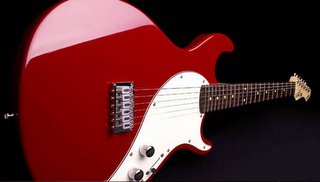Variax
Our  only once, and I used the time to test Line 6’s Variax guitar. I already own one of Line 6’s products, the DL4 Delay Modeler, and I was interested to know if the Variax would live up to my expectations, which had been raised by the DL4’s great performance.
only once, and I used the time to test Line 6’s Variax guitar. I already own one of Line 6’s products, the DL4 Delay Modeler, and I was interested to know if the Variax would live up to my expectations, which had been raised by the DL4’s great performance.
I had read about the Variax prior to my testing but was not aware that it came in various models, so when I played the guitar I did not know that it was actually a Variax 300. I know that now because I checked the product on the internet and saw that the 300 does not have a tremolo bar and has its tuning keys in a single line (the similarly whammy bar-less Variax 500 has three per side).
My first impression of the Variax 300 is that it is an adequate guitar. For a modern guitar it’s not as eye-catching as the Parker Fly, and I still prefer the classic look of the Fender Strat to its rather plain-looking exterior. I was also a little disappointed because in the same store earlier this year I had seen a much better looking – and much higher priced – Variax, which I now think was a 700. Still, the 300 didn’t look bad, and given time I might get to like its Strat-meets-Les Paul shape.
Interestingly, the most striking feature of the Variax series of electric guitars is what it does not have: pickups. Line 6 eschewed tradition and instead used LR Baggs piezo bridge pickups, which I guess makes the guitar’s acoustic setting more realistic. Which brings us to what the Variax is: a modeling guitar that digitally nails the sound of 25 guitars, including the Strat, Tele, Les Paul, and the abovementioned acoustic guitar.
As an acoustic guitar player my interest in the Variax was mainly in its acoustic setting, so that’s the first thing I tried. Getting there was easy: the knob farthest from the player indicates the settings, and I simply turned it until I saw “acoustic.” I was expecting to hear something thin, so I was impressed when I heard a lush sound that did approximate an acoustic guitar. Not airy like a mic’d acoustic, but the same piezo sound given by my Ibanez AW100CE plugged into a good acoustic guitar amp or straight to the mixer.
The five-way switch is supposed to emulate five positions of a mic on an acoustic guitar, but not being trained in this area I didn’t really hear that; what I heard was the standard trebly sound in the bridge position, more middy sound in the middle position, and a bassier sound in the neck position. Positions 4 and 5 gave a modulated sound, kind of like a chorus, which was really pleasant. I ran through several songs my band 220 plays and it sounded really well. The action was a little too low on the display guitar, however, so the high E string gave a little unwanted “twang” as I played. But that’s not something that can’t be fixed by a little setting up.
Aside from the Strat, Tele, and Les Paul settings, the Variax also has settings for jazz guitar and even a resonator. In all these the Variax does a good job, and while snobs will jeer at this, the average player will find all the sounds useful. I personally feel the acoustic sound alone justifies the price of a little over 38,000 pesos (sale price at Perfect Pitch; regular price is over 42,000 pesos). I can imagine owning one of these babies and being able to get all these sounds during gigs – without having to change guitars. It would also solve my perennial problem of going to a gig and finding the sound tech has provided only an electric guitar amp. The price is actually reasonable, and it beats having to own 25 guitars to get all the sounds a single Variax can give.




0 Comments:
Post a Comment
<< Home